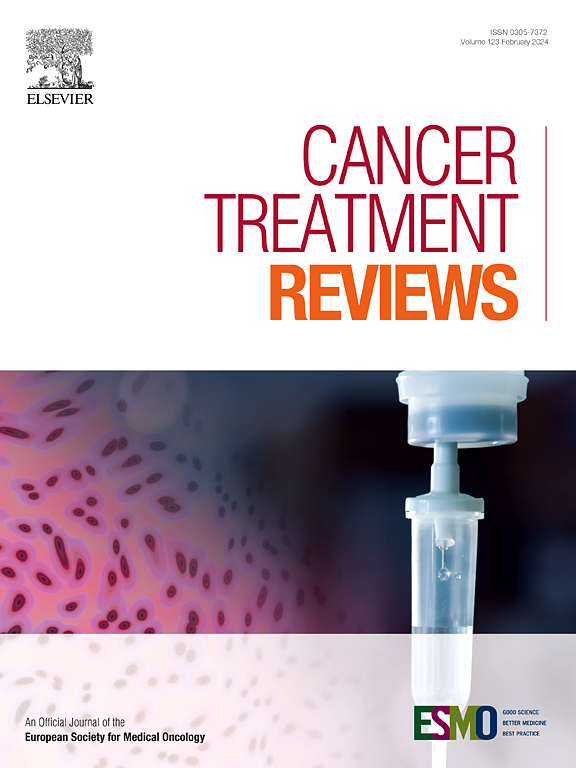治疗乳腺癌的 CAR-T 细胞疗法:现状与未来展望。
IF 9.6
1区 医学
Q1 ONCOLOGY
引用次数: 0
摘要
在不断扩大的乳腺癌(BC)治疗范围内,转移性乳腺癌(MBC)仍然几乎无法治愈,而且往往会对常规治疗产生抗药性,最终导致转移和死亡。细胞免疫疗法(CI),尤其是嵌合抗原受体工程化T细胞(CAR-T),已成为应对这一挑战的一种前景广阔的方法。CAR-T细胞对血液肿瘤有显著疗效,因此也被用于临床需求最大的领域--侵袭性BC患者。遗憾的是,由于肿瘤特异性抗原的稀缺和 BC 病区的免疫抑制微环境,目前的研究结果远远无法复制这种成功。在本文中,我们将对CAR-T细胞疗法在BC中应用的临床前和临床数据进行最新概述。通过调查现有文献,我们讨论了这种治疗方法的主要限制因素,并概述了在乳腺恶性肿瘤中推进这种治疗方法的可能策略。可能的方法包括利用合成生物学来完善抗原靶向和减轻脱靶毒性,利用逻辑门控 CAR 构建来增强特异性,以及利用装甲 CAR 来重塑肿瘤微环境。利用可诱导基因开关和外部触发器对 CAR-T 细胞进行时间和空间调控,可进一步提高安全性和功能性。此外,通过趋化因子受体工程促进 T 细胞归巢,以及利用通用 CAR 平台改进生产工艺,也扩大了治疗的适用性。这些创新不仅解决了抗原逃逸和 T 细胞衰竭问题,还优化了 CAR-T 细胞疗法的疗效和安全性。因此,我们勾勒出了一条轨迹,CAR-T 细胞可能会从一种前景广阔的实验方法发展成为 BC 治疗的标准模式。本文章由计算机程序翻译,如有差异,请以英文原文为准。
CAR-T cell therapy for breast cancer: Current status and future perspective
Within the expanding therapeutic landscape for breast cancer (BC), metastatic breast cancer (MBC) remains virtually incurable and tend to develop resistance to conventional treatments ultimately leading to metastatic progression and death. Cellular immunotherapy (CI), particularly chimeric antigen receptor-engineered T (CAR-T) cells, has emerged as a promising approach for addressing this challenge. In the wake of their striking efficacy against hematological cancers, CAR-T cells have also been used where the clinical need is greatest – in patients with aggressive BCs. Unfortunately, current outcomes fall considerably short of replicating that success, primarily owing to the scarcity of tumor-specific antigens and the immunosuppressive microenvironment within BC. Herein, we provide an up-to-date overview of both preclinical and clinical data concerning the application of CAR-T cell therapy in BC. By surveying the existing literature, we discuss the prevailing constrains of this therapeutic approach and overview possible strategies to advance it in the context of breast malignancies. Possible approaches include employing synthetic biology to refine antigen targeting and mitigate off-target toxicity, utilizing logic-gated CAR constructs to enhance specificity, and leveraging armored CARs to remodel the tumor micro-environment. Temporal and spatial regulation of CAR-T cells using inducible gene switches and external triggers further improves safety and functionality. In addition, promoting T cell homing through chemokine receptor engineering and enhancing manufacturing processes with universal CAR platforms expand therapeutic applicability. These innovations not only address antigen escape and T cell exhaustion but also optimize the efficacy and safety profile of CAR-T cell therapy. We, therefore, outline a trajectory wherein CAR-T cells may evolve from a promising experimental approach to a standard modality in BC therapy.
求助全文
通过发布文献求助,成功后即可免费获取论文全文。
去求助
来源期刊

Cancer treatment reviews
医学-肿瘤学
CiteScore
21.40
自引率
0.80%
发文量
109
审稿时长
13 days
期刊介绍:
Cancer Treatment Reviews
Journal Overview:
International journal focused on developments in cancer treatment research
Publishes state-of-the-art, authoritative reviews to keep clinicians and researchers informed
Regular Sections in Each Issue:
Comments on Controversy
Tumor Reviews
Anti-tumor Treatments
New Drugs
Complications of Treatment
General and Supportive Care
Laboratory/Clinic Interface
Submission and Editorial System:
Online submission and editorial system for Cancer Treatment Reviews
 求助内容:
求助内容: 应助结果提醒方式:
应助结果提醒方式:


